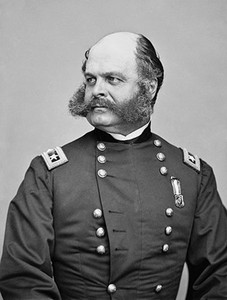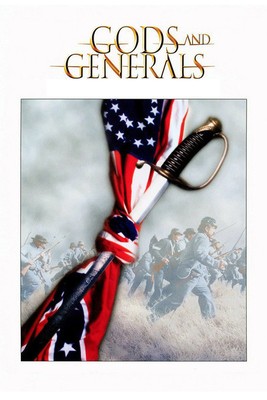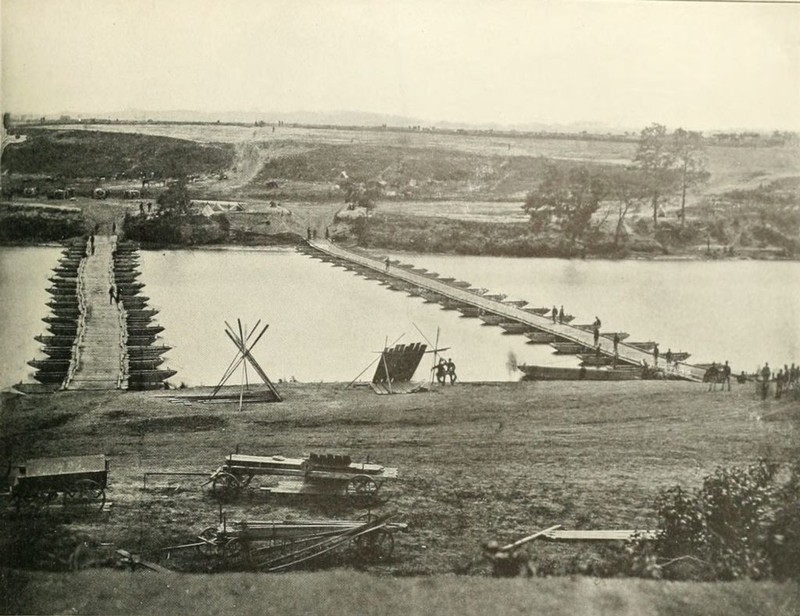The Battle of Fredericksburg
Introduction
Text-to-speech Audio
Images
Battle of Fredericksburg

Map of the battle and infantry movements

Alfred Waud's sketch of the Union charge against the stone wall as seen from this location. This sketch was done for Harper's Ferry Illustrated as the battle raged

Union Commander, General Ambrose Burnside

Mort Kunstler's depiction of the 20th Maine's (Joshua Chamberlin kneeling and firing in center) charge against the stone wall.

Gods and Generals (2003) DVD cover

The pontoon bridges used by the Union

The Phillips House, used by Union General Ambrose Burnside. Taken during the battle

Backstory and Context
Text-to-speech Audio
The town of Fredericksburg, Virginia, is located along the Rappahannock River, around 50 miles southwest of Washington DC. General Ambrose Burnside, Lincoln’s replacement for George McClellan, planned to move his army of 114,000 men on Richmond, hoping he might fool General Robert E. Lee into believing the Union army was headed in one direction, and than turn, cross the Rappahannock, and drive towards Richmond. The key to this plan was to have pontoon bridges in place across the river so the army could take command of the high ground outside of Fredericksburg. Unfortunately, the pontoon bridges, so desperately important to the success of the plan were left behind at Harper’s Ferry. Burnside was aware of this fact when he left Washington, and asked the Union Army General in Chief, Major General Henry Halleck, to have the bridges floated down the Potomac and put in place at Fredericksburg crossing before his army arrived. Didn’t happen. Beginning with Halleck, and moving down the chain of command, Burnside’s message was got lost in the minutia of military politics. When the bridges finally arrived, and element of surprise was lost.
The Confederate forces protecting Fredericksburg was small, around 500 men. Lee’s had divided his command into three separate armies. General James Longstreet’s Corps was near Culpepper, a town almost 20 miles away. General Thomas (Stonewall) Jackson’s Corps was 60 miles away in the Shenandoah Valley. Lee position at Fredericksburg was in danger of being overrun unless he could reorganize his lines quickly.
The
first components of Burnside’s army reached the Rappahannock River at Falmouth,
across from Fredericksburg on November 17, 1862. Without the pontoon bridges in
place, Burnside was forced to wait. Opportunities to throw the full weight of
his overwhelming army on Lee’s exposed positions came and went over the weeks
Burnside delayed his attack. The battle of Fredericksburg did not begin until
December 11, 1862. Over this time, Longstreet had arrived at Fredericksburg on
November 22, and he deployed his Corps of 40,000 men on the hills behind
Fredericksburg. Jackson’s Corps 35,000 men arrived at Fredericksburg on
December 3, having marched 175 miles in 12 days, he was ordered to defend the
area along the river. Now Burnside was facing an army of 75,000 soldiers,
instead of the original garrison of 500. At this point, despite the size of
Burnside’s army, the Union was in trouble.(1)
When the bridge train finally appeared, General Burnside ordered pontoon gear be brought up to the river quickly. It took the pontoon equipment a couple days to be built, and even though the Confederates couldn’t see the Union engineers, they could hear the bridge building tools. Essentially, if the Union didn’t have to wait for the pontoon supplies, the outcome of the war might have been different. The fighting began December 11, 1862, when the Union started to lay down the pontoon equipment. The Union came under fire from the town and General Burnside had his artillery lay siege to the town to force the Confederates to retreat back. The Confederates returned fire on the Union in hopes that it would slow them down. The bombardment from both sides continued for almost two hours (2), and it succeeded driving the Confederates back long enough to allow the Union to finish piecing the boats. Once the boats were finished, General Burnside started to send the troops over the bridge and into the town. The battle started to move into the town and away from a bombardment. The Union army was quickly moving through the town pushing the Confederate troops that were stationed there out. General Jackson’s troops moved into place along the side on the river bank, and General Longstreet’s men were spread 5 miles wide in front of General Lee’s men. The Confederates spread along the main highway just outside the town, even though the Confederate line was stretched so far, they ha entrenched themselves behind a wall. Before the Union soldiers could even reach the line of the Confederates, they would have to go through a massive artillery barrage.
By the morning of December 13th General Burnside ordered the attack on the Confederate lines. General Burnside call for General William Franklin’s division to attack General Jackson’s troops at Marye’s Heights and then have Major General Edwin Sumner follow right behind him. General Burnside’s plan was not well received; many men questioned his moves and why he would send General Franklin, and General Meade to front the attack. In the end, the Union accepted Burnsides’ plan to attack the Confederate lines head-on. The battle started at 8 in the morning, General Meade’s troops opened the attack on General Jackson’s brigade, marching towards the line. A barrage of artillery fire rained down on General Meade’s troops. As Meade’s men continued forward toward the Confederate line, Jackson let the Union troops get to within 500 yards (3) of the tree line where he had placed his canons; once they got close to the railway system, Jackson had his canons open fire on the Union troops. The result was horrific.
As
the dreary day carried on the Union troops were ducking for cover where ever
they could find it. The terrain had little cover, there might have been a tree
or two, but for the most part, the land was pretty much open. General Meade’s
troops were able to find the gap that General Jackson had left open. As the
Union troops pressed further into the woods they had the Confederates in a
retreat. Confederate General Maxcy Gregg was accidentally shot by his own men
who thought he was part of the Union’s advancing army. When General Jackson discovered
the breech, he immediately sent reinforcements, which overwhelmed and drove the
Union forces out of the forest. Any further attack could not happen, until the
Union was able to turn General Jackson’s line. These frontal attacks continued throughout
the whole day. The Confederate artillery rained fire down on the Union troops. With
little protection from the canon fire hundreds Union troops were slaughtered.
But it did not stop General Burnside from sending more troops up the hill to
attack the well dug in Confederates. The Army of the Potomac lost an enormous
amount of troops. General Joseph Hooker’s troops were up next to try and take
that stonewall. Hooker’s men met the same treatment as Meade’s brigade. They
ran up under fire from canon and muskets, avoiding falling over the bodies of
the Union soldiers that had died there earlier. Brigadier General Andrew
Humphrey and his division fared better because they were able to get the
closest to the wall, but like all the other divisions, they were turned back
with heavy losses.
On December 16th, 1862, General Burnside began his retreat from Fredericksburg. He took his pontoon boat with him. By the end on the battle the Confederates lost about 5,000 men. The Union army lost over 12,000 men during this engagement; more than half of the men died at the stone wall. This was the most one-sided battle of the whole war. However, there was one thing the Union would be able to do quickly that the Confederates could not. The North could replace their losses and replenish their supplies fast. The Confederates could not replace their lost troops as readily, but almost as important, restocking the supplies would soon be impossible.
The Union Army lost this battle for a number of reasons. First and foremost, their generals lacked judgment and good sense. The logistics of fighting a large-scale battle was simply beyond their understanding. Second, interference and pressure from Washington caused tremendous problems. Had Burnsides plan of attack taken place close to how it had been drawn up, the war might have ended at Fredericksburg. Burnsides lack of creativity and battle-day planning failed his men. Lee had been out-generaled, his army was divided and separated by a hundred miles, but his subordinates and men quickly responded to their general’s orders and turned the tide of war on a vastly larger army. Furthermore, at several points in the 4-day struggle, Union generals wasted valuable opportunities that might have won the day for the North.(4), Fredericksburg was one of the most one sided battles in the war, but the Union was able to recuperate and live to fight another day.
